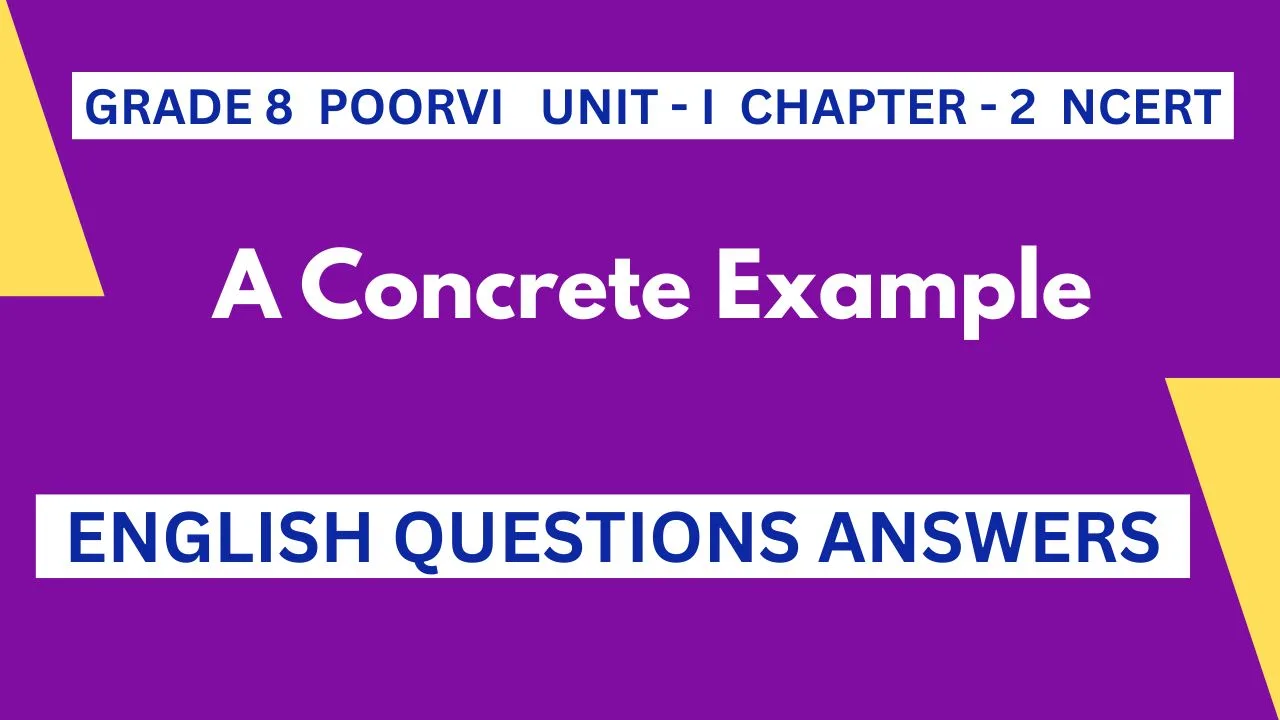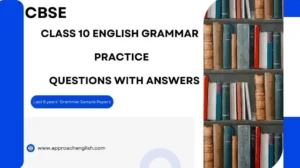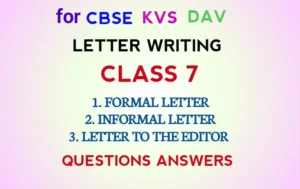A Concrete Example Questions Answers English Class 8 NCERT from POORVI provides detailed solutions to help students understand the story and its important themes. UNIT I Chapter 2 English Class 8 NCERT focuses on comprehension, moral values, and textual understanding. These questions and answers make it easier for students to prepare effectively for exams.
Let us do these activities before we read. (Page 17)
I Read the names of items you usually find in a garden and write their names against each picture given below. garden hose, sapling, hedge, flower beds, flower pot, pebbles, rockery, fence, vine, wheelbarrow
Ans:
Left Column (Top to Bottom):
- Hedge
- Wheelbarrow
- Sapling
- Flower beds
- Fence
Right Column (Top to Bottom):
- Flower pot
- Pebbles
- Garden hose
- Vine
- Rockery
POORVI: Textbook of English for Grade 8 NCERT Solution 2025-2026:
II Work in groups of four. What kind of garden would you like to have? Mention the features that you can include and the reasons for your choice. Share your answers with your classmates and teacher.
Ans: I would like to have a colourful flower garden. It will have a small pond, a stone path, and a swing under a big tree. I would plant roses, marigolds, and sunflowers in flower beds. There will be a fence around the garden and a bench to sit and read. This garden will make me feel peaceful and happy, and I will spend time there every evening.
III Read the title of the poem. What comes to your mind when you read the word ‘concrete’? Does it have more than one meaning? Share your answers with your classmates and teacher.
Ans: When I read the word ‘concrete’, I think of something hard and made of cement, like a building or pavement. But it can also mean something clear or real, like a concrete idea or example. So, the title of the poem “A Concrete Example” may have two meanings – one about stones in the garden (real concrete) and the other about giving a real example (concrete idea).
Let us read (Page 18)
Stanza 1: Summary & Notes
My next-door neighbour, Mrs. Jones,
has got a garden full of stones:
A crazy path, a lily pond,
a rockery and, just beyond
A sundial with a strange device,
which Mrs. Jones thinks rather nice.
Summary (Stanza 1)
The speaker describes his neighbour Mrs. Jones’s unusual garden, which is full of stones. It has a zigzag path, a pond with lilies, a rocky area, and a sundial with a strange design that she finds attractive.
Word Notes
- crazy path – an irregular, winding pathway
- rockery – a garden arrangement made with rocks and plants
- sundial – an old instrument that tells time using shadows
- strange device – an unusual or unique tool attached to the sundial
- rather nice – somewhat charming or pleasing
Literary Devices
- Alliteration – “garden full of stones” (repetition of ‘s’ sound)
- Rhyme Scheme – AABBCC
- Imagery – Describes the visual features of the garden vividly
Stanza 2: Summary & Notes
My next-door neighbour, Mrs. Jones,
puts little plants between the stones
They are so delicate and small,
they don’t mean anything at all.
I can’t think how she gets them in,
unless she plants them with a pin.
Summary (Stanza 2)
The speaker observes that Mrs. Jones plants tiny, delicate plants between the stones. They are so small that he jokes she must plant them using a pin.
Word Notes
- delicate – soft, tiny, and fragile
- don’t mean anything at all – seem insignificant to the speaker
- with a pin – exaggeration implying the plants are extremely small
Literary Devices
- Hyperbole – “unless she plants them with a pin” (exaggeration for effect)
- Rhyme Scheme – AABBCC
- Humour – The speaker’s tone is light and slightly mocking
Stanza 3: Summary & Notes
My next-door neighbour, Mrs. Jones,
once asked me round to see her stones.
We stood and talked about a flower
for quite a quarter of an hour.
“Where is this lovely thing?” I cried.
“You’re standing on it,” she replied.
Summary (Stanza 3)
Mrs. Jones invites the speaker to see her garden. They talk for a long time about a special flower, but the speaker cannot see it. To his surprise, she reveals he has been standing on it all along.
Word Notes
- asked me round – invited the speaker over
- quite a quarter of an hour – 15 minutes
- cried – shouted or exclaimed
- standing on it – unknowingly stepping on the delicate flower
Literary Devices
- Irony – “You’re standing on it” (unexpected and humorous twist)
- Enjambment – Sentences flow from one line to the next
- Rhyme Scheme – AABBCC
- Dialogue – Used to add realism and humour
Let us discuss (Page 19)
I Complete the following summary with exact words from the poem. One example has been done for you. Share your answers with your classmates and teacher.
The poem describes Mrs. Jones, the speaker’s next-door neighbour, who has a unique garden filled with 1.stones . Her garden includes
a peculiar 2.path a pond, and a rockery, along with an unusual 3. sundial that she finds charming. Mrs. Jones plants tiny, 4. delicate plants between the stones, which the speaker thinks must be so small that they are planted with a 5. pin One day, Mrs. Jones invites the speaker to see her garden, and they discuss a 6. flower treasures. When the speaker asks where the 7. flower Mrs. Jones says that the speaker has been 8. standing that Mrs. Jones flower is, on it all along.
II Select the correct option to fill in the blanks for the following sentences.
1. The tone of the poem is
(i) mocking
(ii) humorous.
(iii) mournful
(iv) amusing.
(v) light-hearted.
A. (i), (ii), and (iii)
B. (1), (ii), and (v)
C. (ii), (iii), and (iv)
D. (ii), (iv), and (v)
Ans: D. (ii), (iv), and (v)
2. The speaker in the poem is
(i) Mrs. Jones
(ii) the poet
(iii) a gardener
(iv) a child
Ans: (ii) the poet
3. The rhyme scheme of the poem is
(i) AABBCC
(ii) ABABCC
(iii) AABCAC
(iv) ABBACC
Ans: (i) AABBCC
III Complete the following sentences by choosing the correct answer given in the brackets.
1. The poet uses the word ‘stones’ in all stanzas in order to emphasise her (obsession with a stony garden/pride in gardening skills)
Ans: obsession with a stony garden
2. The poet uses imagery to describe the features of the garden that help (understand Mrs. Jones’ love for plants/visualise readers the garden’s peculiar nature)
Ans: visualise the garden’s peculiar nature
IV Pick examples of alliteration from the poem.
Ans: Alliteration from the Poem
- “puts little plants”
- “stood and talked”
- “full of flowers” (if considered by poetic sound)
V A refrain is a repeated line or phrase that appears in each stanza Identify the refrain from the poem.
Ans: “My next-door neighbour, Mrs. Jones”
VI Irony is a literary device that emphasises the difference between what is “expected and what actually happens. It often involves a situation where the outcome is the opposite of what is expected, creating a surprising or a humorous effect. For example, Mrs. Jones’ excitement about her garden contrasts with the speaker’s disappointment on how ordinary it is. Identify the line(s) from the poem that display(s) situational irony.
Ans: Situational Irony Line(s)
“Where is this lovely thing?” I cried.
“You’re standing on it,” she replied.
This is ironic because the speaker expected a beautiful, visible flower, but it was so small, it was underfoot!
VII Complete the following sentences appropriately.
1. The word ‘concrete’ can refer to _______________ in Mrs. Jones’ garden.
Ans: stones and the path
2. The title also has a symbolic meaning, as the poem provides a clear or ‘concrete’ example of Mrs. Jones’ _____________ gardening habits.
Ans: unusual gardening habits.
VIII The title ‘A Concrete Example’ carries both literal and symbolic (metaphorical) meaning. Such word play is called a pun. A pun is a figure
of speech that uses words with multiple meanings or words that sound alike but have different meanings, creating a humorous effect.
- I tried arguing with my pencil but it kept making sharp points. (suggests the idea of an actual sharp pencil point and strong argument points)
- My pencil and I had a disagreement but we finally got to the point (refers to solving an argument and the pencil’s tip)
Ans: The title “A Concrete Example” is a pun. It means two things. First, it refers to real concrete or stones in the garden. Second, it gives a clear example of someone’s strange gardening habits. So, “concrete” means both the material and something clear or real. This wordplay makes the title funny and smart. It helps us see how the poem is about both actual stones and a real example.
Let us think and reflect (Page 20)
I Read the given extract and answer the questions that follow.
1. My next-door neighbour, Mrs. Jones,
has got a garden full of stones:
A crazy path, a lily pond,
a rockery and, just beyond
A sundial with a strange device,
which Mrs. Jones thinks rather nice.
(i) What can be inferred about Mrs. Jones’s taste in gardening from the description of her garden being ‘full of stones”?
Ans: Mrs. Jones likes a garden full of stones, a rockery, a lily pond, and a strange sundial. This shows she likes things that are different or odd. She does not care about big, bright flowers but enjoys small, unusual plants and strange objects. Her garden is special to her and not like a normal flower garden.
(ii) Identify whether the following statement is true or false.
The garden serves as a means to reveal more about Mrs. Jones herself.
Ans: Statement: The garden reveals more about Mrs. Jones
True – Her garden shows her love for unusual and tiny things.
(iii) What does the poet mean by ‘crazy path’?
Ans: A “crazy path” means a path that is not straight. It might be made with stones placed in a fun or messy way. It could go in many directions and look a bit wild or strange. It adds character to her garden.
(iv) What does the sundial with a ‘strange device’ suggest about Mrs. Jones’ personality?
A. She has a fascination with unusual items.
B. She prefers traditional garden decorations.
C. She is uninterested in her garden’s appearance.
D. She likes modern and expensive items.
Ans: A. She has a fascination with unusual items.
II Answer the following questions.
1. How does Mrs. Jones feel about her garden?
Ans: Mrs. Jones loves her garden. She finds joy in her stones, tiny plants, and sundial. She even invites the speaker to see her garden and talks about a flower for fifteen minutes. She thinks her garden is beautiful and enjoys showing it. Her care for small details shows how proud she is.
2. Why does the speaker mention planting with a pin?
Ans: The speaker says the plants are so delicate and small that it looks like Mrs. Jones plants them with a pin. This means they are very tiny. The speaker is amazed at how she fits them between the stones, showing how small and carefully placed they are.
3. What do we learn about Mrs. Jones?
Ans: Mrs. Jones is a cheerful and unique person. She enjoys small plants, stones, and unusual things like a sundial. She proudly shows her garden and talks about it. Her style is different, but she finds joy in it. She is also kind, as she invites the speaker to see her garden.
4. Poem shows Mrs. Jones positively:
Ans: Yes, the poem shows Mrs. Jones as someone who loves her garden and enjoys simple, strange things. She is friendly and happy to share her garden. Her joy in tiny plants and a sundial shows her creativity and care. The poet may find her odd, but she is shown with respect and kindness.
5. People think differently – message of the poem:
Ans: The poem teaches us that people see the world in different ways. Mrs. Jones sees beauty in stones and tiny flowers. The speaker expects something big and lovely but is surprised by how small the flower is. It shows that what one person finds beautiful, another may not. We should accept different views.
Let us learn (Page 21)
I Select the appropriate word from the brackets that correctly replaces the underlined word in the sentences from the text.
1. A sundial with a strange device,
(unusual, peculiar, new, rare, external)
Ans: peculiar (A sundial with a peculiar device)
2. … which Mrs. Jones thinks rather nice.
(pleasant, superior, agreeable, gentle, charming)
Ans: charming (which Mrs. Jones thinks rather charming)
3. They are so delicate…
(delicious, fragile, dainty, graceful, weak)
Ans: fragile (They are so fragile)
4. “Where is this lovely thing?” I cried.
(exclaimed, wept, shouted, announced, whispered)
Ans: exclaimed (“Where is this lovely thing?” I exclaimed)
II The ‘sundial’ is referred to as a ‘device’ in the poem. Work in pairs to infer the meaning of ‘device’. Share your thoughts with your classmates and teacher.
Now, match the type of instruments in Column 1 with their definitions in Column 2. Column 3 shows one example of each type of instrument Add more examples in Column 3.
Ans: A device in the poem refers to something mechanical, unique, or specially made—here, it’s a sundial, which is a time-telling instrument using sunlight. So, in general, a device is an instrument or tool designed for a specific purpose, often small and cleverly made.
Match the Instrument Types
| Column 1 | Column 2 (Definition) | Column 3 (Examples) |
| 1. implement | (v) something used by hand to make or repair | spade, knife, chisel, trowel |
| 2. tool | (iii) something that works on being moved by hand | hammer, screwdriver, wrench |
| 3. equipment | (iv) a set of necessary items for a particular purpose | cricket bat, helmet, batting gloves |
| 4. appliance | (i) something that is electrical and is used to do work | mixer grinder, toaster, washing machine |
| 5. gadget | (ii) something small that is mechanical or electronic | mobile phone, laptop, smartwatch |
III Complete the table by making new words in Column 1 using the hint given in Column 2. Replace the first letter of the given word to create new words. One example has been done for you.
Column 1: From “nice”
| Original Word | New Word | Meaning |
| nice | dice | cut into small pieces (as in vegetables) |
| rice | rice | grain that we cook |
| mice | mice | plural of mouse |
| vice | vice | bad habit |
Column 2: From “soil”
| Original Word | New Word | Meaning |
| boil | boil | heat something |
| toil | toil | work very hard |
| coil | coil | length of wire in a circle |
| foil | foil | sheets to wrap food items |
Let us listen (Page 23)
I You will listen to a presentation about the wonderful Rock Garden of Chandigarh. As you listen, answer the following questions using one to three exact words from the presentation. (Transcript for teacher on page 47)
1. Where was Nek Chand’s Rock Garden featured?
Ans: Nek Chand’s Rock Garden was featured on an Indian postage stamp in 1983.
2. What kind of sculptures does the Rock Garden have?
Ans: The Rock Garden has several colourful sculptures and mosaic art pieces.
3. How is the Rock Garden divided?
Ans: The Rock Garden is divided into three distinct phases.
4. Name any one thing that has been transformed into a piece of art in the Rock Garden.
Ans: Broken toilet pots have been transformed into pieces of art in the Rock Garden.
5. Approximately, how many statues border the Rock Garden?
Ans: Approximately 5,000 statues border the Rock Garden.
Let us speak (Page 23)
I The speaker of the poem might have felt sorry for stepping on Mrs. Jones’ flower. When we make a mistake, we must express regret and apologise for our actions.
1. When we apologise to a friend or a family member, we use informal language. Take turns to apologise for the following situations and
respond to the apology.
(i) You have eaten your brother’s share of sweets.
(ii) You have broken your sister’s flower craft.
(iii) You accidentally spilled ink on your mother’s important documents.
(iv) You forgot to bring your friend’s notebook to the school after borrowing
Apology and Response Phrases Table
| Phrases for Apology | Phrases to Respond to Apology |
| I’m sorry about… | That’s alright. |
| I’m really sorry… | It’s no big deal. |
| Please forgive me for… | No problem. |
| Sorry, I didn’t mean to… | These things happen. |
2. When we apologise to someone in authority like a Principal or a teacher in a formal setting, we use formal language. Work in pairs and take turns to apologise for the following situations and respond to the apology.
(i) You did not bring an assignment that was due for submission.
(ii) You were late to school for the past three days and had to meet the Principal.
(iii) You did not submit your project work and were asked to explain.
You may use the phrases given below.
Formal Apology and Response Phrases Table
| Phrases for Apology | Phrases to Respond to Apology |
| I’m extremely sorry for… | I accept your apology. |
| I promise it won’t happen again. | Please ensure you… |
| I owe you an apology for… | I appreciate you saying this, but… |
| I’ll do my best not to repeat it. | I’m glad you realised your mistake… |
| I really regret… | – |
| I assure you that this will never happen again. | – |
Let us write (page 25)
You are a member of the Nature Club of your school. Draft a notice informing the students in Grades 6 – 8 about the inauguration of the Herb Garden.
Points to remember:
- Mention the purpose of writing, date, time, venue and any other relevant information – whom to contact, when, and where.
- Use formal language in the third person form.
- Write a notice in a box.
| NAME OF THE ORGANISATION NOTICE Date: _____________ Title: ___________________________ Body of the Notice: (Write the content here. Include what the notice is about, date, time, venue, who can participate, and what to do.) Name: ___________________ Signature: _______________ Class: ___________________ |
| ST. MARY’S SCHOOL, KOLKATA NOTICE Date: 11 July 2025 Visit to Amrit Udyan – Educational Tour All students of Classes VI to VIII are hereby informed that the school is organizing an educational tour to Amrit Udyan, Rashtrapati Bhavan, New Delhi on 25 July 2025 (Friday). Students will get to explore the famous gardens, including Bal Vatika, Bonsai Garden, and Arogya Vanam.Reporting Time: 7:30 a.m. at the school gateDeparture: 8:00 a.m. sharpReturn Time: 6:30 p.m.Charges: ₹300 per student (includes travel and snacks) Interested students must submit the permission slip and amount to their class teacher by 18 July 2025.For further details, contact the undersigned. (Signed) Ritika Sharma Cultural Secretary |
III Read and enjoy the poem.
A Sea of Foliage
A sea of foliage girds our garden round,
But not a sea of dull unvaried green,
Sharp contrasts of all colours here are seen;
The light-green graceful tamarinds abound
Amid the mango clumps of green profound,
And palms arise, like pillars gray, between;
And o’er the quiet pools the seemuls lean,
Red-red, and startling like a trumpet’s sound.
But nothing can be lovelier than the ranges
Of bamboos to the eastward, when the moon
Looks through their gaps, and the white lotus changes
Into a cup of silver. One might swoon
Drunken with beauty then, or gaze and gaze
On a primeval Eden, in amaze.
TORU DUTT
Extra Questions:
Extract 1
Read the extract and answer the questions:
A sea of foliage girds our garden round,
But not a sea of dull unvaried green,
Sharp contrasts of all colours here are seen;
The light-green graceful tamarinds abound
Amid the mango clumps of green profound,
And palms arise, like pillars gray, between;
Questions and Answers
(i) What surrounds the garden according to the poet?
➡️ The garden is surrounded by a sea of foliage, which means thick greenery all around.
(ii) What does the poet mean by “not a sea of dull unvaried green”?
➡️ The greenery is not boring or the same; it has many colours and shades.
(iii) What kind of contrast is seen in the garden?
➡️ The poet sees sharp contrasts of colours—light green tamarinds and dark green mangoes.
(iv) Which trees are described as light-green and graceful?
➡️ The tamarind trees are described as light-green and graceful in the garden.
(v) How does the poet describe the palms?
➡️ The palms stand tall between other trees and are compared to gray pillars.
Extract 2
Read the extract and answer the questions:
And o’er the quiet pools the seemuls lean,
Red-red, and startling like a trumpet’s sound.
But nothing can be lovelier than the ranges
Of bamboos to the eastward, when the moon
Looks through their gaps, and the white lotus changes
Into a cup of silver. One might swoon
Drunken with beauty then, or gaze and gaze
On a primeval Eden, in amaze.
Questions and Answers
(i) What does the poet compare the red seemul flowers to?
➡️ The red seemul flowers are bright and loud in colour, like the sound of a trumpet.
(ii) Which plant does the poet find the loveliest in moonlight?
➡️ The poet finds the bamboo ranges to the east the loveliest when the moon shines through them.
(iii) How does the moonlight affect the white lotus?
➡️ In moonlight, the white lotus looks like a glowing silver cup.
(iv) What emotion does the poet feel while looking at the garden?
➡️ The poet feels deeply moved and amazed, almost fainting from the beauty.
(v) What does the poet compare the garden to at the end of the poem?
➡️ The poet compares the garden to a primeval Eden, a beautiful paradise from the beginning of time.







